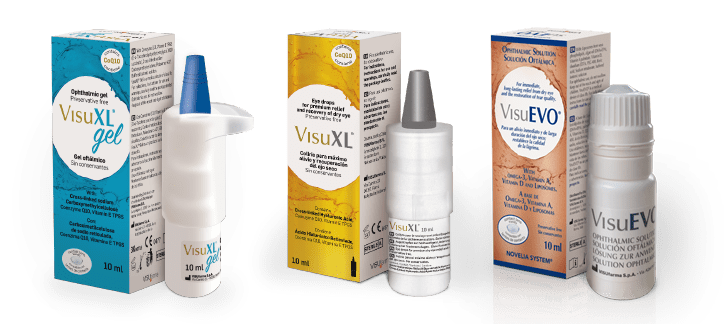How to Find Your Perfect Eye Drop
Eye drops can be used to treat various eye problems, and they come in many different shapes and sizes. For example, you might receive prescription eye drops from your doctor to treat an infection, or if you are suffering from dry, itchy eyes, you might look for an over the counter eye drop to ease your symptoms. 1
What is Dry Eye Syndrome?
If your eyes are itchy, streaming or irritated, you might be suffering from Dry Eye Syndrome. This condition can be caused by many factors, including if you are over 50 or going through menopause, side effects of certain drugs, related conditions, or even lifestyle choices like smoking or drinking alcohol.2
How can eye drops help?
Lubricating eye drops are the most common treatment of Dry Eye, to ease irritating symptoms. 3
However, there are many types of eye drops, and different eye drops work for different people. It depends on the causes, severity and symptoms of your Dry Eye as to which eye drop you should be using.
This blog explores some of the main types of eye drops you can use, to help you identify your perfect eye drop.
What are artificial tears?
Artificial tears are eye drops used to lubricate dry eyes and help maintain moisture on the outer surface of your eyes. 4 Artificial tears are available over the counter, and there are many different types. Xalin ® tears, for example, are designed to moisturise the eye and alleviate redness, irritation and eye fatigue associated with Dry Eye Syndrome. 5
What is the difference between preservative and preservative-free eye drops?
Some eye drops contain a preserving ingredient called benzalkonium chloride (BAK) to keep the drops sterile, and some don’t. 6 If you suffer from Dry Eye and use eye drops on a regular basis, it’s best to consider a preservative-free eye drop, as the alternative can harm the cells in your eyes over time and even lead to your symptoms getting worse. 7
What are gel drops?
Gel eye drops are a type of lubricating eye drop. They are a liquid that turns into a gel as soon as it touches the surface of the eye, so are thicker than ordinary liquid eye drops.8 Gel drops like VisuXL ® Gel can be ideal for treating more severe Dry Eye, and for relieving symptoms at night. 9
How should I use eye drops?
Eye drops can be used as the last phase of a three-step treatment plan, to effectively manage chronic Dry Eye Syndrome.
Step 1: Apply a heated compress, such as MeiboPatch ® , to unblock your meibomian glands and relieve your eyes.
Step 2: Cleanse and wipe away the melted oil blocking your glands, as well as any built up debris with a cleanser like Naviblef ® , that is specially designed to reduce discomfort. 10
Step 3: Incorporate an eye drop from the VISUfamily range into your daily routine, to effectively manage your symptoms over time.
In most cases, the best way to treat dry eyes, Also known as dry eye syndrome, is to use eye gel or eye drops.
VisuXL Gel® is a preservative-free smart gel lubricant for dry eye syndrome. It provides comfort in a bottle with it’s long-lasting lubrication properties giving 12-hour dosing with just one drop and is suitable for both day and night use.
VisuXL® is a preservative-free eye drop lubricant for dry eye syndrome. Due to its unique ingredients, VisuXL® will help you recover from eye surgery, an injury or persistent damaging dry eye.
VisuEvo® is a preservative-free eye drop that prevents excessive evaporation of the tear film. Its unique formula contains omega-3 essential fatty acids, Vitamins A and D and ultra-filtered phospholipids that facilitate tear film presentation and control evaporation.
All three products are contact lens-friendly and can be used for 180 days after opening.
Shop now
There are many different eye drops on the market, so it is ultimately best to consult your GP before starting any treatment plan, especially if your condition is serious.
For more advice about choosing Dry Eye treatments, click here.
To see which eye drops can be used with contact lenses, click here.
In most cases, the best way to treat dry eyes, Also known as dry eye syndrome, is to use eye gel or eye drops.
VisuXL Gel® is a preservative-free smart gel lubricant for dry eye syndrome. It provides comfort in a bottle with it’s long-lasting lubrication properties giving 12-hour dosing with just one drop and is suitable for both day and night use.
VisuXL® is a preservative-free eye drop lubricant for dry eye syndrome. Due to its unique ingredients, VisuXL® will help you recover from eye surgery, an injury or persistent damaging dry eye.
VisuEvo® is a preservative-free eye drop that prevents excessive evaporation of the tear film. Its unique formula contains omega-3 essential fatty acids, Vitamins A and D and ultra-filtered phospholipids that facilitate tear film presentation and control evaporation.
All three products are contact lens-friendly and can be used for 180 days after opening.
Shop now
References:
- University of Illinois, ‘How to Use Eye Drops’, Healthline, https://www.healthline.com/health/general-use/how-to-use-eye-drops Accessed Jan 2022.
- NHS England, ‘Dry Eyes’, https://www.nhs.uk/conditions/dry-eyes/, Accessed Jan 2022.
- ‘What Causes Dry Eyes, WebMD, https://www.webmd.com/eye-health/eye-health-dry-eyes
- Alaina, L. ‘Artificial Tears: How to Select Eye Drops for Dry Eyes’, Mayo Clinic, https://www.mayoclinic.org/diseases-conditions/dry-eyes/expert-answers/artificial-tears/faq-20058422 Accessed Jan 2022.
- Xalin Tears Instrunctions for Use (IFU)
- Waton, Kathryn. ‘What to Know About Preservative-Free Eye Drops, Plus Products to Consider’, Heathline, 20/11/19, Accessed Oct 2021: https://www.healthline.com/health/preservative-free-eye-drops
- Malik Y. Kahook, MD,and Aurora, Colo, ‘The Pros and Cons of Preservatives’, Review of Opthamology, 15/04/15.
- Dresden, Danielle, ‘Some of the Best Gel Eye Drops for Dry Eyes for 2022’, Medical News Today, 13/10/21, https://www.medicalnewstoday.com/articles/best-gel-eye-drops, Accessed Jan 2022.
- Ranieri, Miranda, MD, ‘Eye Drops vs. Gel vs. Ointment: What’s the Difference?’, Queensway Optometric Centre, 11/08/11, https://queenswayoptometric.com/eye-drops-vs-gel-vs-ointment-whats-the-difference/ Accessed Jan 2022.
- Navibelf Instructins For Use (IFU)
- VisuXL Instructions For Use (IFU)
- Brancato R, Fiore T, Papucci L, et al. Concomitant Effect of Topical Ubiquinone Q10 and Vitamin E to Prevent Keratocyte Apoptosis After Excimer Laser Photoablation in Rabbits. J Refract Surg 2002; 18: 135-9.




